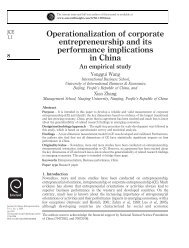Corporate entrepreneurship: teaching managers to be entrepreneurs
Corporate entrepreneurship: teaching managers to be entrepreneurs
Corporate entrepreneurship: teaching managers to be entrepreneurs
Create successful ePaper yourself
Turn your PDF publications into a flip-book with our unique Google optimized e-Paper software.
entrepreneur. When experience, creativity <strong>to</strong>ols, coaching, and a person’sown confidence and desire collide with market knowledge, cus<strong>to</strong>merintimacy information, and technological changes, entrepreneurialopportunities are identified. We could not predict with any accuracywho would <strong>be</strong> in the intersection at the right time, but providing thisintersection in a planned way did result in brand new businesses andsignificant innovation in current businesses. In addition, we could notpredict which of our would-<strong>be</strong> <strong>entrepreneurs</strong> would <strong>be</strong> motivated. OurMBA star arrived motivated, <strong>be</strong>came unmotivated and then quit. Ourolder engineer arrived unmotivated, got excited and stayed. So theinteresting research question is, what are the key ingredients for causingthe right kinds of collisions at the intersection. We know some of theelements but not others..Decoupling ideation and opportunity identification from implementation.As we looked at our four companies, we discovered that some individualsreally do have the right stuff <strong>to</strong> identify, develop, and implement a newbusiness venture from start <strong>to</strong> finish. They are akin <strong>to</strong> many start-up<strong>entrepreneurs</strong>. We also encountered people who were good at the creativeopportunity identification and shaping phases, but who could not or didnot want <strong>to</strong> implement their idea. For them, the fun was in theconceptualization piece, not the implementation piece. Thus, anycorporate <strong><strong>entrepreneurs</strong>hip</strong> process must first <strong>be</strong> framed around thequestion of whether a company wants <strong>to</strong> develop corporate<strong><strong>entrepreneurs</strong>hip</strong> processes or corporate <strong>entrepreneurs</strong>. The processapproach means that a company does not expect the same people <strong>to</strong>develop and then implement a new business, but they want the structuresand processes in place, which help <strong>to</strong> identify, shape, and then capture anew business opportunity. Many companies are starting <strong>to</strong> build oralready have, some form of entrepreneur process in place. Intel, Proc<strong>to</strong>r &Gamble, Ford, Dow and others are exploring and testing these variousmachines of innovation. Obviously not all of these structures work(Altman, 2000) but companies seeking greater innovation are increasinglyexploring new avenues. An emphasis on identifying and supporting a“corporate entrepreneur” who is expected <strong>to</strong> follow a new opportunityfrom start <strong>to</strong> finish is a relatively new model and one that does not requirethe same investment in fixed assets. We do know that passion counts andinstitutionalized processes do not always take this in<strong>to</strong> account. Perhapscompanies seeking innovation need <strong>to</strong> pursue both paths..The last lesson is that a little difference can make a big difference. Notevery manager needs <strong>be</strong> an entrepreneur <strong>to</strong> help a company spawnsignificant new business opportunities. Several of our examples,particularly the $250 million dollar one, attest <strong>to</strong> this. So companiesneed <strong>to</strong> <strong>be</strong> realistic about how much corporate <strong><strong>entrepreneurs</strong>hip</strong> is<strong>Corporate</strong><strong><strong>entrepreneurs</strong>hip</strong>343
















